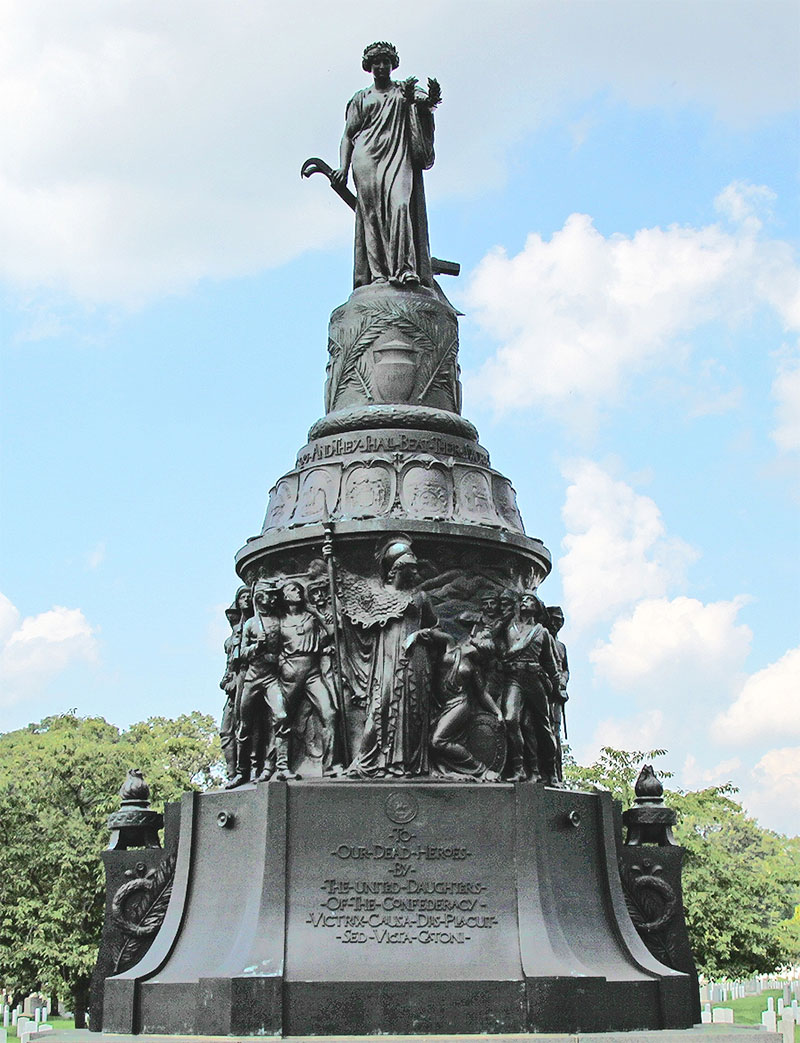
The Advisory Committee on Arlington National Cemetery has recommended the removal of the 32-foot-tall memorial to Confederate veterans buried there on the grounds that it is “riddled with racist iconography” and perpetuates the Lost Cause narrative. The following letter was sent today to the Committee. — JAB
On March 19, 1841, at the consecration of its new synagogue in Charleston, Rabbi Gustavus Poznanski of the Kahal Kadosh Beth Elohim congregation rose to speak to a throng of temple members and Charlestonians of many faiths who were invited to witness the important occasion. For centuries Jews all over the world had sought a return to the Promised Land, and generations of families had vowed as much at their annual Passover Sedar, “Next year in Jerusalem!” In a remarkable display of chutzpah, Rabbi Poznanski proclaimed, “…this synagogue is our temple, this city our Jerusalem, this happy land our Palestine.” The Jews had finally found a home.
In his book, American Jewry and the Civil War, Rabbi Bertram Korn, the recognized expert in the field, seems quite emphatic that during the antebellum period, Jews experienced a cultural and religious renaissance in the South that was unrivaled. Jews who lived in the region adopted the southern way of life with all its peculiarities, including slavery, because for the first time in modern history, they were treated with dignity and respect, and flourished culturally, politically, and economically on par with their Christian neighbors. Korn concluded, “Nowhere else in America–certainly not in the ante-bellum north—had Jews been accorded such an opportunity to be complete equals as in the old South.”
And while we condemn the evils of slavery then and now all over the world, we cannot pass judgement on our ancestors as viewed through the 21st century lens of equity, diversity, and inclusion. No previous generation of Americans can survive such scrutiny.
Francis Salvador of South Carolina was the first Jew elected to public office in the colonies when chosen for the Provincial Congress in 1774. David Yulee and Judah Benjamin were chosen by their State Legislators, as was the practice then, to represent Florida and Louisiana in the U.S. Senate. They were the only Jewish Senators during that period. After the war, Isaac “Ike” Hermann, a private in the 1st Georgia Infantry proclaimed, “I found in [the South] an ideal and harmonious people; they treated me as one of their own; in fact, for me, it was the land of Canaan where milk and honey flowed.” Southern Jewry, in the antebellum period, had found in the South the haven from prejudice they had been looking for.
No doubt this was on the mind of Moses Ezekiel when he designed and created the memorial at Arlington Cemetery. Arlington Monument is an important piece of American history, Jewish-American history, and a significant work of art. Arlington itself is property originally seized from Confederate General Robert E. Lee’s family, in an act of retribution, a deliberate attempt to prevent Lee or his descendants from ever being able to see their cherished home again. But in an ironic twist, the Lee home place at Arlington has become sacred ground, universally revered by all Americans.
In the aftermath of the terror and hardship of war, Americans greatly desired to be done with the division and bitter sectional strife they had so recently endured. They wanted to reunite the country in a spirit of harmony.
To that noble end, it was appropriate that in 1900, less than 40 years from Lee’s surrender, Congress authorized the interment of the corporeal remains of Confederate soldiers in the hallowed earth of Arlington, and in 1914, permission was gladly given to erect a prominent memorial to the Confederate dead in the midst of Arlington.
This inspiring monument was erected to acknowledge the heroic manhood of Southern men who fought bravely against overwhelming odds, and to acknowledge a former foe in a spirit of renewed friendship and kindred national sentiment.
After all, in just a few years after the dedication of this beautiful monument, America would call on her sons to join the expedition to Europe, to fight in World War I; Americans answered that call, and fought side by side — northerners and southerners together, united in a common purpose.
As President William McKinley offered southerners in 1898: “[We] should share with you in the care of the graves of Confederate soldiers…. Sectional feeling no longer holds back the love we feel for each other. The old flag again waves over us in peace with new glories.”
Have we not seen in so many other places around the world that political disagreements have inflamed into civil wars which have carried on for generations costing many unnecessary lives?
We believe your committee — far removed from the actual conflict — should not assume the role of arbiter in this matter. Now, more than 100 years since it’s unveiling, you make pronouncements with no appreciation or regard for those who came before you and those who will follow. You cannot comprehend the hardships, the misery and the motivations of the men and women, on both sides of the conflict, who lived through this generational tsunami. Why must you call for these symbols of unity and reconciliation to be destroyed? Forever. Why must you insert your personal political ideologies of the moment for the time-honored traditions cultivated by generations of Americans?
We ought to respect the decision of those men who were far closer to the conflict than we are and honor their efforts to set aside the horrors of war in the name of peace.
Regardless of the political considerations, destroying or relocating this beautiful memorial would be the worst kind of vandalism and iconoclasm. Ezekiel is also buried there, and Jewish Law sharply condemns the excavation and removal of corpses from their gravesites even when they will be reburied elsewhere.
Designed by Moses Ezekiel, America’s first great Jewish sculptor and a veteran himself, the Arlington Confederate Monument is a true masterpiece. To remove, damage, or alter this great achievement by one of America’s noblest sons would be a crime against history, against art, and against the spirit of reunification that led to its creation. Judaism teaches us that loved ones never die if there is someone left to remember them. This monument is a testament to the memory of thousands who died and brings comfort and solace to their descendants.
We would urge you to leave the Arlington Confederate Memorial exactly as our forefathers intended it.
Jack Schewel
Journey of Souls and Writer
Lynchburg, VA
Rabbi Eric B. Wisnia
Philadelphia, PA
Lew Regenstein
Author and Writer
Atlanta, GA
Robert Marcus
Historian and Filmmaker
Chapel Hill, NC
Paul Gottfried
American Philosopher & Historian
Elizabethtown, PA
-----------------------
Jack Schewel is a writer and filmmaker in Virginia.
- Read more on the Abbeville Institute
















